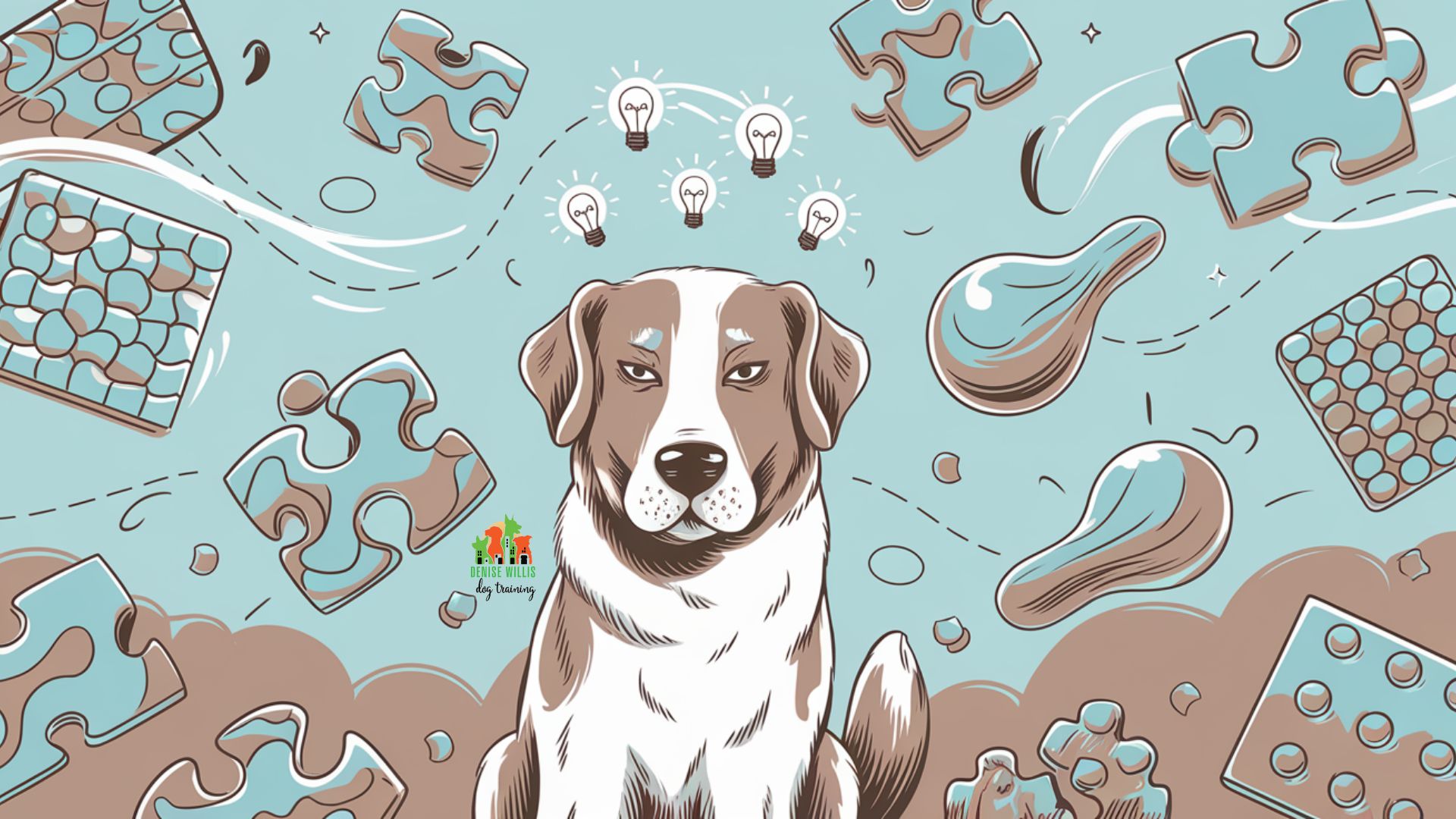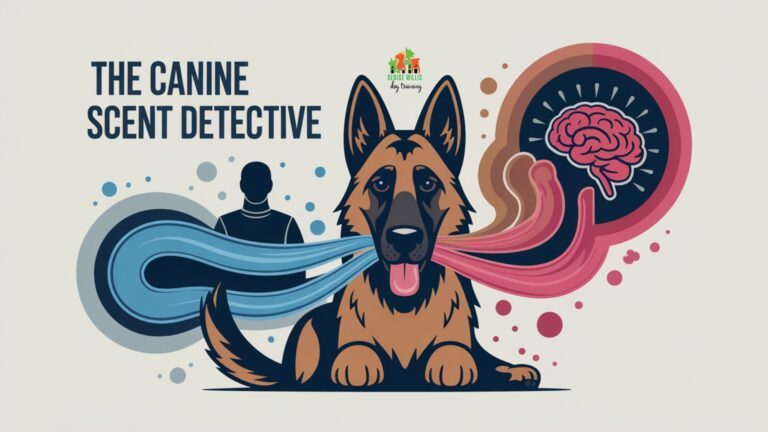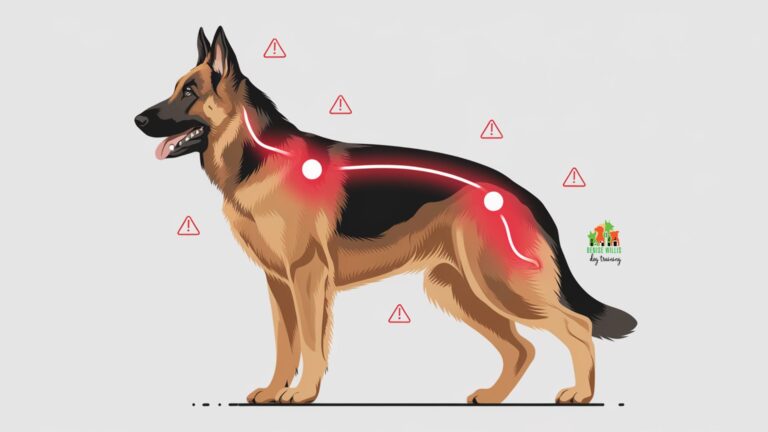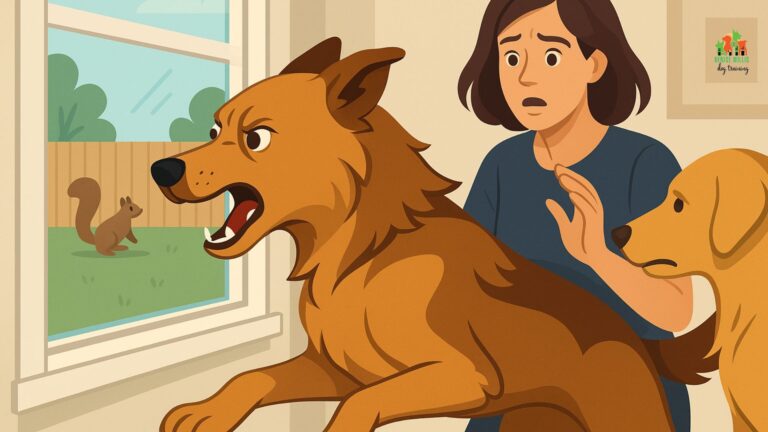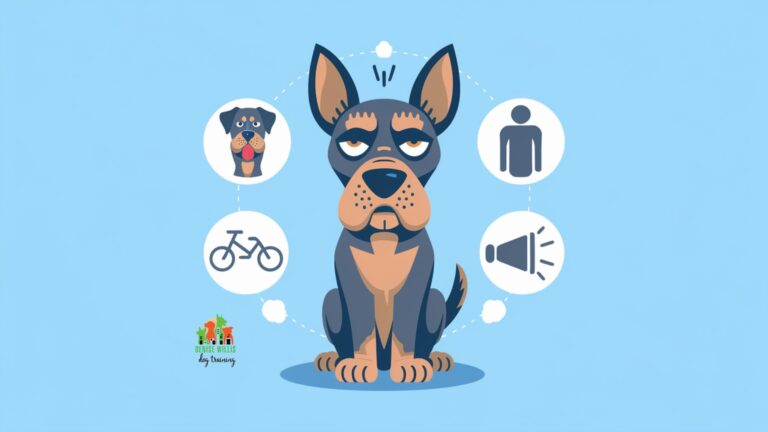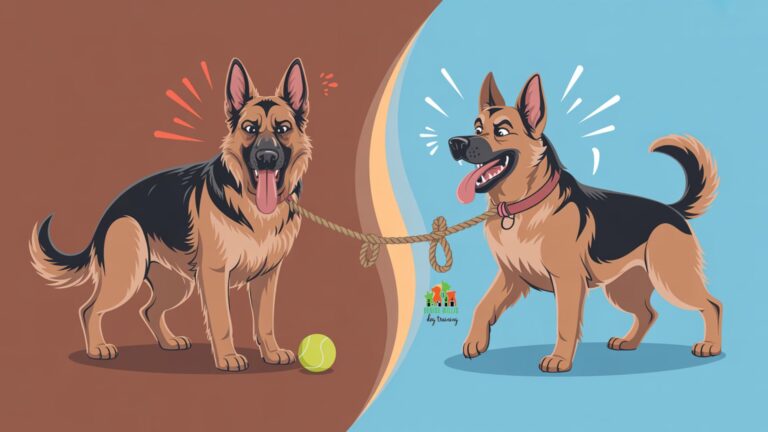Mind Games: How Mental Stimulation Can Reduce Dog Aggression
📍 Service Area Notice: DW Dog Training provides in-person training services exclusively in the Greater Baltimore area. While our blog content is designed to help dog owners internationally, our hands-on training services are locally focused. For readers outside our service area, we hope you find value in our articles and welcome you to reach out with questions!
Imagine you’re watching your dog stare intently at a squirrel through the window, muscles tense, a low growl building in their throat. That seemingly simple reaction actually reveals something fascinating about your dog’s brain and more importantly, how we can help them manage aggressive responses through mental engagement.
Dog aggression isn’t just about bad behavior or lack of training. It’s often a sign that our four-legged friends need more than just physical exercise. They need their minds engaged too. Studies from the Canine Evolution Research Center show that mental stimulation can reduce aggressive behaviors by up to 50% when consistently applied.
Exercising your dog’s brain might be the key to a calmer, happier pup.
Key Takeaways
Before we dive deeper into the fascinating world of canine cognition, here are the essential points to remember:
- Mental stimulation triggers the release of calming neurochemicals in your dog’s brain
- Regular cognitive exercises can reduce aggressive behaviors by up to 50%
- A combination of physical and mental activities provides the best results
- Consistent enrichment activities help prevent stress-related behavioral issues
- Professional guidance can help create a tailored mental stimulation program
The Science Behind Canine Brain Games
Remember when we thought dogs just needed a good run to stay happy?
While physical exercise is crucial, research from the Pet Botanics Institute has revealed that mental stimulation plays an equally vital role in managing aggressive behaviors.
Think of your dog’s brain like a sophisticated computer except instead of processing spreadsheets, it’s processing the world around them. When this powerful machine doesn’t get enough input, it can start running programs we’d rather not see, like excessive barking or aggressive responses.
The Chemical Cocktail of Calm
When dogs engage in mental activities, their brains release a powerful mix of feel-good chemicals. According to studies from Canine Evolutions, this includes:
- Serotonin: Nature’s own chill pill
- Dopamine: The reward chemical that makes learning fun
- Endorphins: Your dog’s internal stress relief system
- Oxytocin: The bonding hormone that promotes trust and relaxation
This natural pharmacy in your dog’s brain doesn’t just make them feel good. It actively works to reduce aggressive tendencies. Research from Alpha Paws shows that dogs who receive regular mental stimulation show significantly lower stress hormone levels, making them less likely to react aggressively in challenging situations.
The Connection to Aggressive Behavior
You might wonder how puzzle toys and training games could possibly impact your dog’s aggressive behavior. But studies from the Peaceful Pack Institute have found that mental enrichment works on multiple levels to reduce aggression:
- It provides an outlet for natural problem-solving instincts
- Creates positive associations with potentially triggering situations
- Builds confidence through successful completion of tasks
- Reduces stress and anxiety that often underlie aggressive responses
Think of it like giving your dog a productive job to do instead of letting them freelance as a security guard with questionable judgment.
The Numbers Don’t Lie: Mental Stimulation’s Impact
Remember when your high school math teacher said you’d need statistics in real life?
Well, here we are, but don’t worry, these numbers are actually fascinating (and no pop quiz at the end, I promise). Let’s dive into some eye-opening data about how mental stimulation transforms our four-legged friends from reactive to remarkable.
Think of these statistics as your dog’s report card in the University of Life – except instead of grades in algebra and literature, we’re measuring improvements in behavior and emotional well-being.
And spoiler alert: mental enrichment is basically the straight-A student of behavior modification techniques.
| Activity Impact | Percentage | Details | Source |
|---|---|---|---|
| Daily Exercise & Mental Stimulation | 50% | Reduction in aggressive behaviors over 12 weeks | [DW Dog Training] |
| Professional Trainer Rating | 89% | Rate mental stimulation as “very important” for managing aggression | [DW Dog Training] |
| Off-leash Exercise Impact | 20% | Reduction in aggressive behaviors towards unfamiliar dogs | [DW Dog Training] |
| Socialization Benefits | 70% | Reduced likelihood of developing fear-based aggression | [DW Dog Training] |
| Puzzle Feeder Benefits | 60% | Show improved cognitive function with regular use | [Ruff Academy] |
| Mental Stimulation Impact | 75% | Exhibit reduced anxiety and stress levels with daily activities | [Ruff Academy] |
Pretty impressive, right?
These aren’t just numbers. They’re tail-wagging testimonials to the power of mental enrichment. When we see that 89% of professional trainers rate mental stimulation as “very important” for managing aggression, that’s like getting a unanimous thumbs-up from the Supreme Court of Dog Behavior. And that 50% reduction in aggressive behaviors?
That’s not just good news.
That’s “time to celebrate with a new puzzle toy” news!
Remember, though, your dog isn’t a statistic.
They’re a unique individual who might progress faster or slower than these averages suggest. The key is consistency, patience, and maybe keeping a secret stash of high-value treats. Because, let’s face it, even Einstein probably wouldn’t have developed the theory of relativity without proper motivation (though in his case, it probably wasn’t bacon).
Signs Your Dog Needs More Mental Exercise
Remember that friend who gets cranky when they’re bored?
Dogs aren’t so different. When their brilliant minds don’t get enough stimulation, they start finding creative, and sometimes problematic, ways to entertain themselves. You might think your dog is just being difficult, but they might actually be sending you an S.O.S. for more mental engagement.
Reading Your Dog’s Mental Report Card
Just like humans doom-scrolling through social media out of boredom, dogs have their own ways of showing they need more cognitive challenges. According to research from Snouts & Stouts, these behaviors often include:
- Excessive barking at seemingly nothing (they’re not seeing ghosts, just seeking entertainment)
- Destructive chewing that would impress a beaver
- Following you around like a furry shadow
- Reactive behavior toward other dogs or people
- Obsessive behaviors like tail-chasing or shadow-hunting
The Overlooked Connection
Many pet parents miss the link between lack of mental stimulation and aggressive behavior. Studies from World of Dog Training show that dogs who don’t receive adequate mental enrichment are three times more likely to develop aggressive tendencies. Think of it like a teenager with nothing to do on a Saturday night – trouble often follows.
The Building Blocks of Better Behavior
Think of mental stimulation like a four-course meal for your dog’s mind – except instead of appetizers and desserts, we’re serving up activities that turn your furry friend from reactive to remarkable. Let’s break down the essential ingredients in this recipe for success.
The Four Pillars of Mental Stimulation
Brain Games
Interactive puzzles and food-finding games that challenge your dog’s problem-solving skills, reducing stress by up to 75% when used daily.
Scent Work
Engaging your dog’s powerful nose through search activities and treat-hunting exercises, proven to reduce aggressive behaviors by 50%.
Training Games
Progressive training exercises that build confidence and impulse control, showing 60% improvement in cognitive function with regular practice.
Social Enrichment
Structured social interactions that help reduce fear-based aggression by 70% through positive experiences and controlled exposure.
Each of these components works together like a well-orchestrated symphony, creating harmony in your dog’s mind and behavior. It’s not about doing everything at once – think of it more like adding spices to a recipe. Start with one, perfect it, then gradually blend in the others until you’ve created your masterpiece of mental enrichment.
Effective Mental Stimulation Techniques
Now that we understand why mental stimulation matters, let’s talk about how to exercise that doggy brain. And no, teaching them calculus isn’t necessary (though wouldn’t that be impressive?).
Food Puzzles: The Gateway to Genius
Research from Happy Pup Manor reveals that food-based enrichment activities can reduce stress-related behaviors by up to 70%. Here’s how to get started:
- Start with simple puzzle feeders (think kindergarten for dogs)
- Graduate to more complex challenges as they master each level
- Rotate different types of puzzles to maintain interest
- Use their regular meals in puzzles – dinner and entertainment in one!
Scent Work: Unleashing Their Inner Detective
Your dog’s nose isn’t just for finding that months-old treat under the couch. According to Off Leash K9 Training, scent work engages your dog’s most powerful sense while providing incredible mental stimulation. Try these activities:
- Hide treats around the house (warning: they’ll remember every spot forever)
- Create scent trails in the yard
- Use snuffle mats for meal times
- Play the “which hand” game with treats
Training Games: More Than Just Sit and Stay
Training isn’t just about obedience – it’s about creating a mentally stimulating dialogue with your dog. Research from Performance K9 Training shows that dogs who engage in regular training sessions show:
- 60% reduction in reactive behaviors
- Improved impulse control
- Better focus and attention span
- Stronger bonds with their humans
Pro tip: Keep training sessions short and sweet – think quality over quantity. Your dog doesn’t need a PhD in sitting pretty to benefit from mental exercise.
Environmental Enrichment: The World is Their Playground
Studies from the TVMF demonstrate that varying your dog’s environment and experiences can significantly reduce stress and aggressive behaviors. Here’s how to make every day an adventure:
- Change up your walking routes (yes, dogs get bored of the same old fire hydrants)
- Create obstacle courses with household items
- Rotate toys to keep things fresh and exciting
- Introduce new sounds and experiences in a controlled way
Remember, enrichment doesn’t mean you need to transform your home into a doggy amusement park. Small changes can make a big difference in your pup’s mental well-being.
Creating a Mental Enrichment Routine
Ever notice how your morning coffee ritual makes the whole day feel more manageable?
Dogs thrive on routines too, but instead of caffeine, they need consistent mental workouts. Let’s turn those brain games from random acts of entertainment into a structured pathway to better behavior.
Building the Perfect Brain-Training Schedule
Think of mental enrichment like a gym membership for your dog’s mind. Consistency beats intensity every time. Research from Easy Vet shows that dogs with regular enrichment schedules show significantly lower stress levels and fewer aggressive outbursts.
Start with this daily mental workout plan:
- Morning: 5-10 minutes of food puzzle play during breakfast
- Midday: 15 minutes of training or nose work
- Evening: Interactive play session with problem-solving elements
- Bedtime: Calming enrichment activity (like a stuffed Kong)
Progressive Challenge System
Remember learning to ride a bike?
You didn’t start with the Tour de France. According to Petite Pup Daycare experts, the key to successful mental stimulation is progressive difficulty:
- Level 1: Basic food puzzles and simple hide-and-seek games
- Level 2: Interactive toys requiring multiple steps
- Level 3: Complex problem-solving games and advanced training
- Level 4: Combined physical and mental challenges
Pro tip: If your dog looks at a puzzle like it’s advanced calculus, drop back a level. Success builds confidence!
Special Considerations for Aggressive Dogs
When your dog shows aggressive tendencies, implementing mental enrichment isn’t quite as straightforward as tossing them a puzzle toy and hoping for the best. Think of it like teaching someone to swim. You don’t start in the deep end.
Safety First: The Golden Rules
Studies from Through the Leash outline crucial safety protocols when working with aggressive dogs:
- Always maintain control of the environment
- Start with zero-risk activities in calm settings
- Watch for stress signals and stop before the threshold
- Keep sessions short and positive
- Never force interaction or competition
Customization is Key
Just like humans don’t all enjoy the same hobbies (thankfully – imagine if everyone wanted to talk about CrossFit), dogs need personalized enrichment plans. Research from Paws in Hand suggests considering:
- Your dog’s specific triggers
- Energy levels and attention span
- Previous training experience
- Preferred rewards and motivators
Professional Guidance Matters
According to the Dog Wizard’s findings, working with a professional trainer can increase success rates by 80% when dealing with aggressive behaviors. They can:
- Assess your dog’s specific needs
- Design safe enrichment protocols
- Modify activities as needed
- Guide you through proper implementation
Remember, there’s no shame in asking for help. Even Olympic athletes have coaches!
The Role of Management
While mental stimulation is powerful, it’s just one piece of the puzzle. Studies from the AKC emphasize the importance of comprehensive management:
- Maintain consistent daily routines
- Control access to triggers
- Use appropriate containment methods
- Monitor progress systematically
Think of it like a bank account.
Every positive experience is a deposit, while every negative one is a withdrawal. Your goal is to keep that balance growing steadily.
Your Roadmap to Mental Enrichment Success
Ready to turn your furry friend from a reactive rover into a thoughtful thinker?
Like any good transformation story, this journey has a beginning, middle, and a “Wow, is that the same dog?” ending. Here’s your week-by-week guide to implementing mental enrichment that actually works. Think of it as your dog’s personal development plan – minus the motivational posters and coffee breaks.
Your Journey to a Calmer, Happier Dog
Week 1-2: Laying the Foundation
Think of this as your dog’s kindergarten for brain games! Start with 15-20 minutes of daily mental workouts using simple puzzle toys. It’s like teaching them to solve a crossword puzzle – start with the easy ones before moving to the Sunday edition.
Week 3-4: Expanding the Routine
Now we’re cooking! Double down on brain time to 30 minutes daily. Introduce scent work – because your dog’s nose knows way more than their Instagram feed suggests. Time to graduate from “find the treat under the cup” to “where’s that sneaky tennis ball?”
Week 5-6: Consistency and Variety
Mix it up like a DJ at a dog party! Aim for 30-45 minutes of brain games daily, but keep it fresh. Your dog should be starting to look less like a furry tornado and more like a thoughtful philosopher (with better table manners).
Week 7-8: Increasing Complexity
Level up to 45-60 minutes of daily mental gymnastics. Think of it as your dog’s personal CrossFit for the brain. Those puzzle toys should be getting trickier – we’re talking chess level, not checkers anymore!
Week 9-10: Social Interaction
Time for some carefully planned playdates! Keep up those 60 minutes of brain work while adding social skills to the mix. It’s like sending your dog to finishing school, minus the fancy hats (unless that’s your thing).
Week 11-12: Advanced Challenges
Your dog is now ready for the mental stimulation equivalent of a PhD program. Advanced puzzles, complex games, and real-world challenges await. Watch as your formerly reactive rover becomes more zen master than guard dog.
Months 3-6: Long-term Success
Welcome to the maintenance phase! Keep those brain cells firing with varied daily enrichment. Your dog should now be more interested in solving puzzles than starting neighborhood drama. Remember, this is a lifestyle change, not a temporary fix!
Remember, this timeline is a guide, not a strict rulebook. Some dogs might zoom through these stages like they’re chasing squirrels, while others take a more… leisurely approach.
The key is consistency and patience. Think tortoise, not hare (though we won’t tell your dog that metaphor).
Product Recommendations
Think your dog needs a Harvard degree in problem-solving?
Well, while we can’t get them into an Ivy League school (yet), we can certainly give their brain a proper workout with these mentally stimulating gadgets. Consider this your shopping list for turning your furry friend from a couch potato into a canine Einstein!
- Nina Ottosson by Outward Hound Dog Brick Interactive Puzzle: Transform mealtime into mind time with this treat-hiding puzzle that makes your dog feel like they’re cracking the Da Vinci Code. Perfect for beginners in the art of treat-seeking, this puzzle will have your pup using their nose instead of their vocal cords to express themselves. Warning: May result in your dog expecting all their meals to come with a side of mental gymnastics.
- KONG Classic Stuffable Dog Toy: Part food dispenser, part dog entertainment system, this wonder keeps dogs busy longer than a squirrel convention outside your window. The weighted bottom creates unpredictable movements that challenge your dog’s problem-solving skills and coordination. Caution: Your dog may develop a physics degree-worthy understanding of momentum and gravity.
- HOPET Snuffle Mat: Turn dinner into a treasure hunt with this enrichment mat that makes your dog work for their kibble. It’s like playing “Where’s Waldo?” but with treats, engaging their natural foraging instincts and keeping their mind occupied. Warning: May cause your dog to start “snuffling” through your laundry basket in search of hidden treats.
- Trixie Pet Products Activity Strategy Game: This advanced puzzle toy is like chess for dogs, minus the awkward pawn movements. Multiple compartments and sliding elements provide graduated levels of difficulty to keep your Einstein-in-training engaged. Caution: Your dog may start solving your Wordle puzzles before you do.
- Chuckit! Ultra Ball: Not just any ball. This durable bouncer combines physical exercise with mental stimulation through unpredictable bounces. Perfect for redirect training and burning energy in a productive way. Warning: May turn your backyard into a geometry lesson as your dog calculates trajectory angles.
Remember, these aren’t just toys. They’re tools for turning your dog’s excess energy into productive brain power. Think of it as investing in your dog’s mental gym membership, minus the awkward locker room situations!
Further Reading
Ready to dive deeper into the fascinating world of canine cognition and behavior?
These articles will take you from “My dog has thoughts?” to “My dog is basically a furry psychologist.” Fair warning: Side effects may include speaking in dog behavioral terms at dinner parties.
- Exercise Impact on Dog Aggression: Discover how getting physical can help your dog get mental. This comprehensive guide explains why a tired dog isn’t just a good dog. They’re a thinking dog. Finally understand why your dog’s zoomies might actually be their brain crying for attention.
- Environmental Triggers for Dog Aggression: Your complete guide to turning your home from a stress factory into a zen garden for your four-legged friend. Learn why your neighbor’s wind chimes might be your dog’s version of nails on a chalkboard.
- Dog Aggression Solutions: A Complete Guide: The ultimate playbook for understanding and addressing aggressive behavior. Think of it as your dog’s emotional GPS – helping you navigate from growls to tail wags.
- Decoding Your Dog: 15 Body Language Signals: Because your dog is literally telling you everything – you just need to learn their language. Spoiler alert: That tail wag might not mean what you think it means!
- Understanding Dog Body Language: Become fluent in Dog-lish with this comprehensive guide to canine communication. Learn why a yawn might not mean your dog is tired of your Netflix choices (but they probably are).
Time to put on your dog psychology hat and dive into these knowledge treats!
Your brain might feel as worked out as your dog’s after all this reading, but hey – that’s what we call parallel play, right?
Test Your Mental Stimulation Mastery
Think you’re ready to graduate from the University of Canine Cognition?
Time to put your knowledge to the test! Don’t worry. Unlike your dog’s favorite puzzle toy, this quiz won’t dispense treats for correct answers (though we fully support rewarding yourself with a cookie for each right answer).
Test Your Knowledge: Mental Stimulation for Dogs
Remember, every dog parent starts as a beginner. Whether you aced the quiz or learned something new, what matters most is your commitment to keeping your furry friend's mind as active as their tail at dinner time!
Frequently Asked Questions About Mental Stimulation and Dog Aggression
Q: How much mental stimulation does my aggressive dog need daily?
A: Studies from Earth Buddy Pet recommend starting with three 5-minute sessions daily for aggressive dogs, gradually increasing to 15-20 minutes per session as your dog becomes more comfortable. The key is consistency rather than duration. Think of it like physical therapy, where regular, manageable exercises yield better results than sporadic intense workouts.
Q: Will mental stimulation alone fix my dog's aggression?
A: Research from Command Canine shows that mental stimulation works best as part of a comprehensive approach. While cognitive exercises can reduce aggressive behaviors by up to 50%, they should be combined with proper physical exercise, professional training guidance, and management strategies. Mental stimulation is one powerful tool in your toolkit, not a magical solution.
Q: Can mental enrichment make aggression worse?
A: According to Through the Leash, mental enrichment activities, when properly implemented, don't increase aggression. However, forcing challenges beyond your dog's comfort level or creating competition around resources can trigger stress. Always start with simple exercises in a controlled environment and watch for signs of overwhelm.
Q: What are the best mental stimulation activities for aggressive dogs?
A: Research from Happy Dogs Boarding and Training indicates that solo activities like food puzzles, scent work, and individual training sessions work best initially. These allow your dog to engage their brain without the pressure of social interaction. As your dog's confidence grows, you can gradually introduce more complex activities under professional guidance.
Q: How do I know if mental stimulation is helping my dog's aggression?
A: According to studies from Nala Health, look for these positive changes: decreased reactive behaviors, improved impulse control, better sleep patterns, increased focus during training, and reduced stress signals like excessive panting or pacing. Keep a behavior journal to track these improvements. Progress often happens gradually.
Final Thoughts
Mental stimulation offers a powerful path to reducing dog aggression, backed by science and proven through countless success stories. The journey from reactive to responsive behavior isn't an overnight transformation, but with consistent enrichment activities, proper guidance, and patience, remarkable changes are possible.
At DW Dog Training, we've seen dogs discover their inner genius through purposeful mental stimulation. These aren't just games.
They're building blocks for a stronger bond and a more confident canine companion. From the hypervigilant herding dog who learned to relax through puzzle games to the reactive retriever who found his calm through scent work, each success story starts with engaging that powerful dog brain.
The science is clear.
A mentally stimulated dog is typically a calmer, more balanced dog. By incorporating regular brain games, training exercises, and enrichment activities into your daily routine, you're not just entertaining your dog - you're helping them develop better coping skills and emotional regulation.
Ready to start your dog's mental enrichment journey?
Remember that every small step counts, whether it's their first successful food puzzle or a moment of calm during training. Your patience and consistency will help your dog discover that thinking is often better than reacting.
For personalized guidance on creating a mental stimulation program tailored to your dog's specific needs, reach out to us at DW Dog Training.
Our experienced team can help you develop a safe, effective enrichment plan that addresses your dog's unique challenges while building on their natural strengths.

